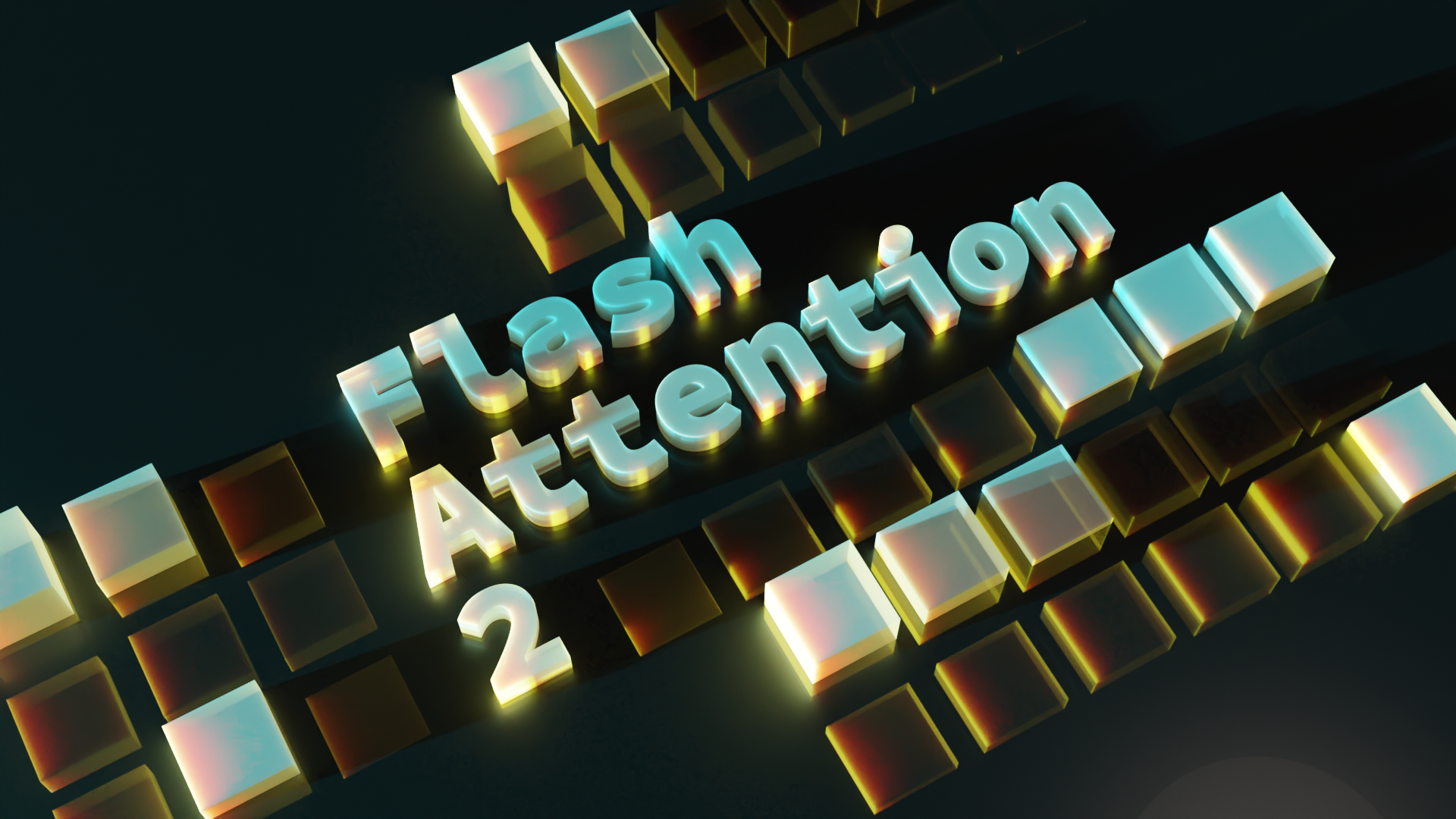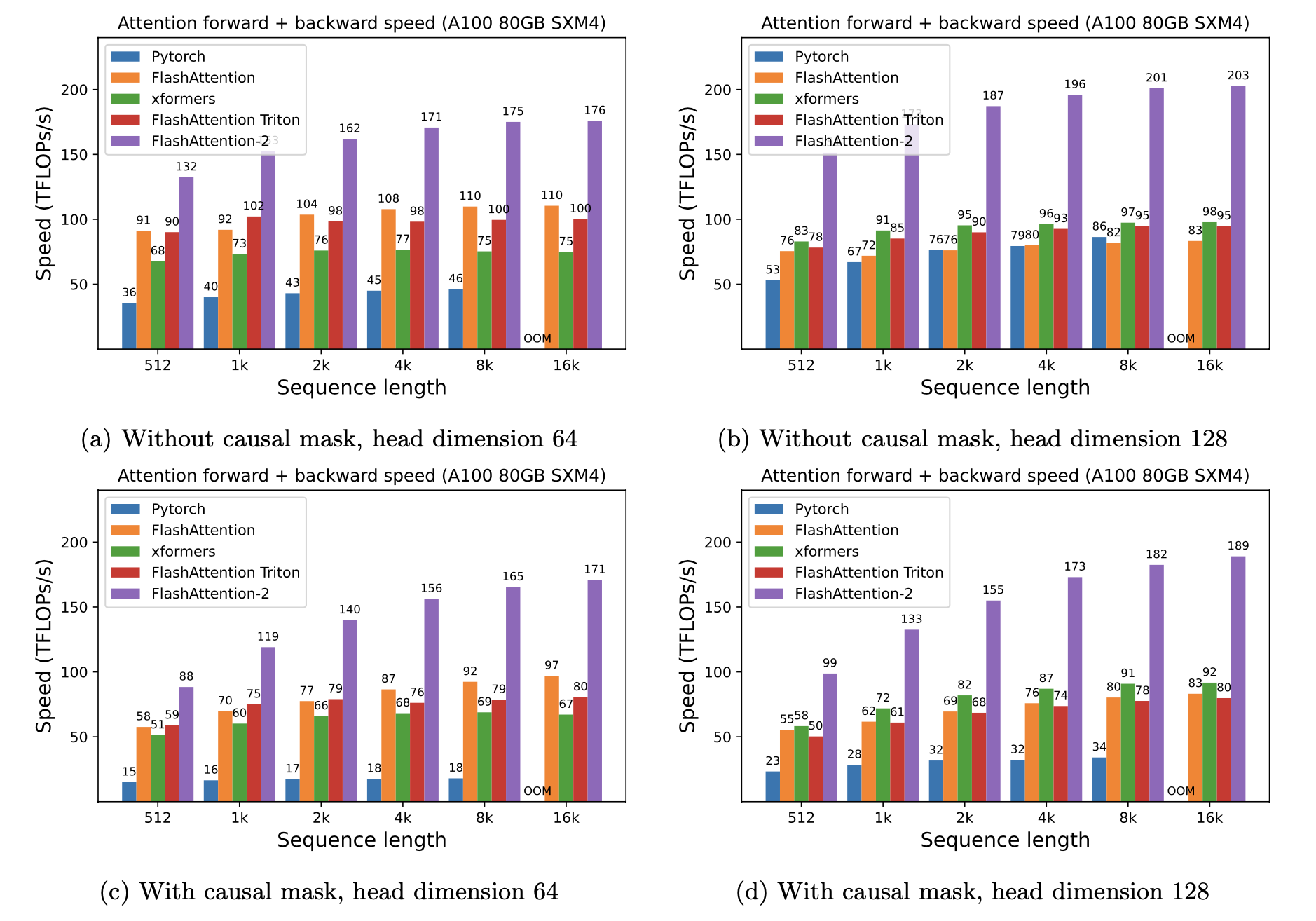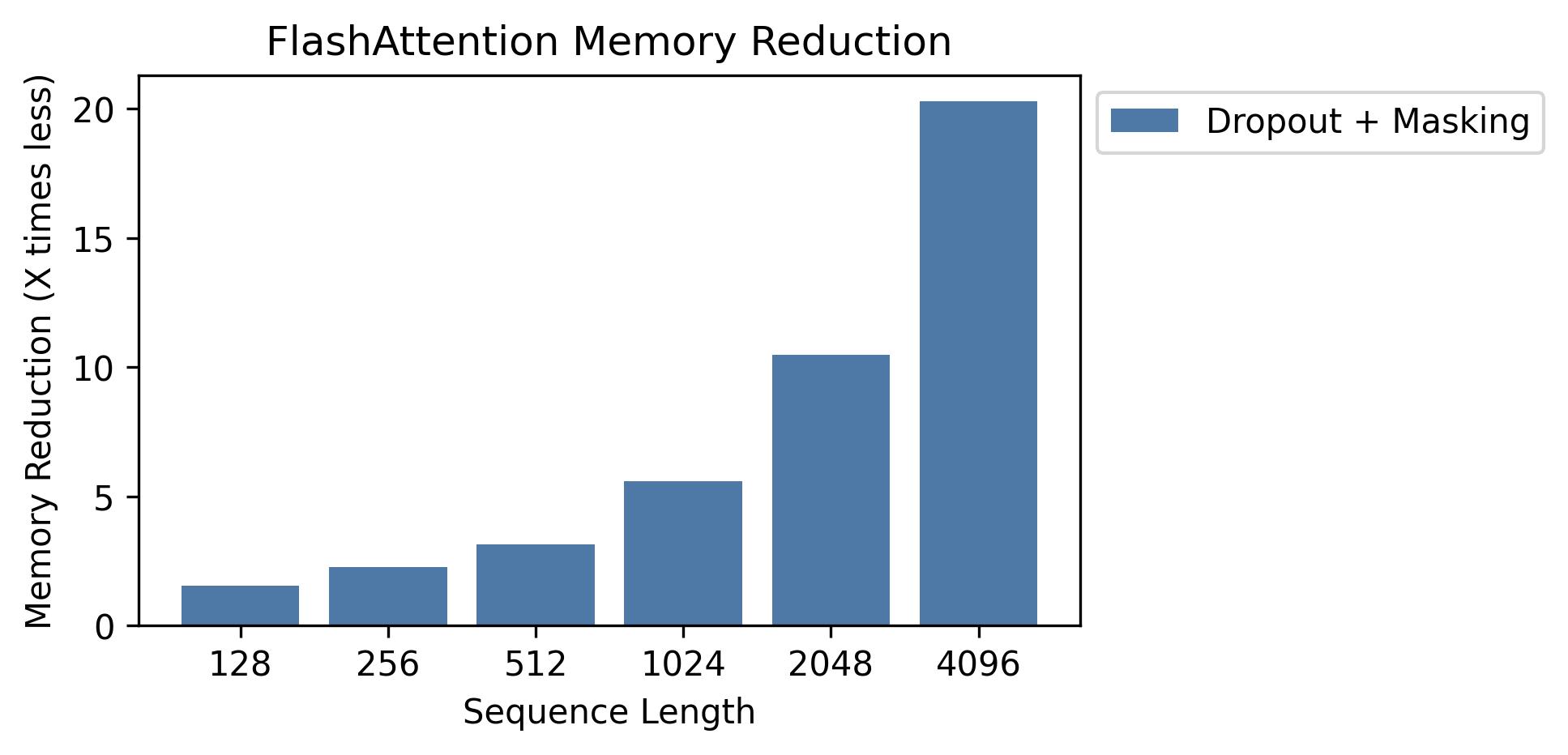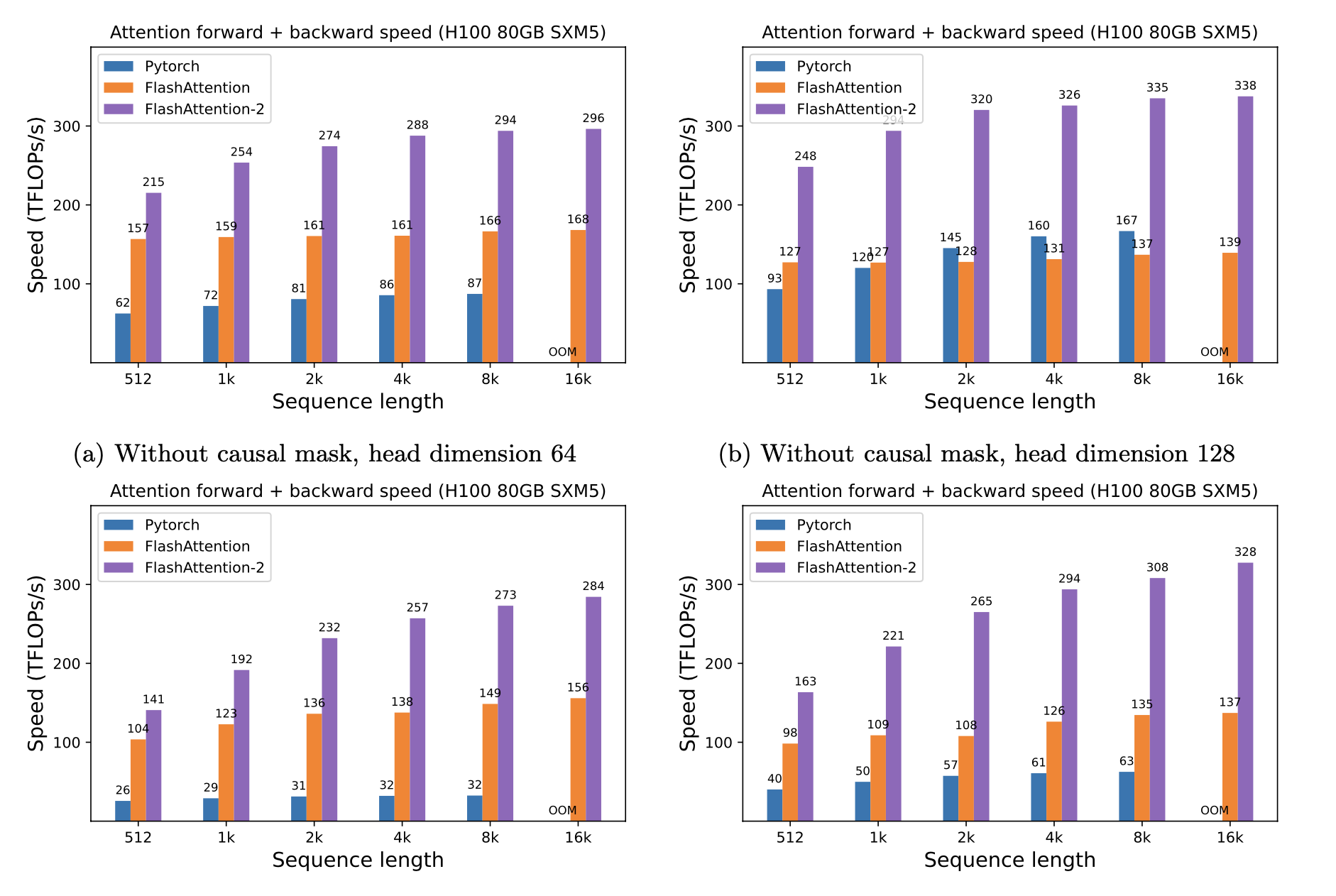This repository provides the official implementation of FlashAttention and FlashAttention-2 from the following papers.
FlashAttention: Fast and Memory-Efficient Exact Attention with IO-Awareness
Tri Dao, Daniel Y. Fu, Stefano Ermon, Atri Rudra, Christopher Ré
Paper: https://arxiv.org/abs/2205.14135
IEEE Spectrum article about our submission to the MLPerf 2.0 benchmark using FlashAttention.
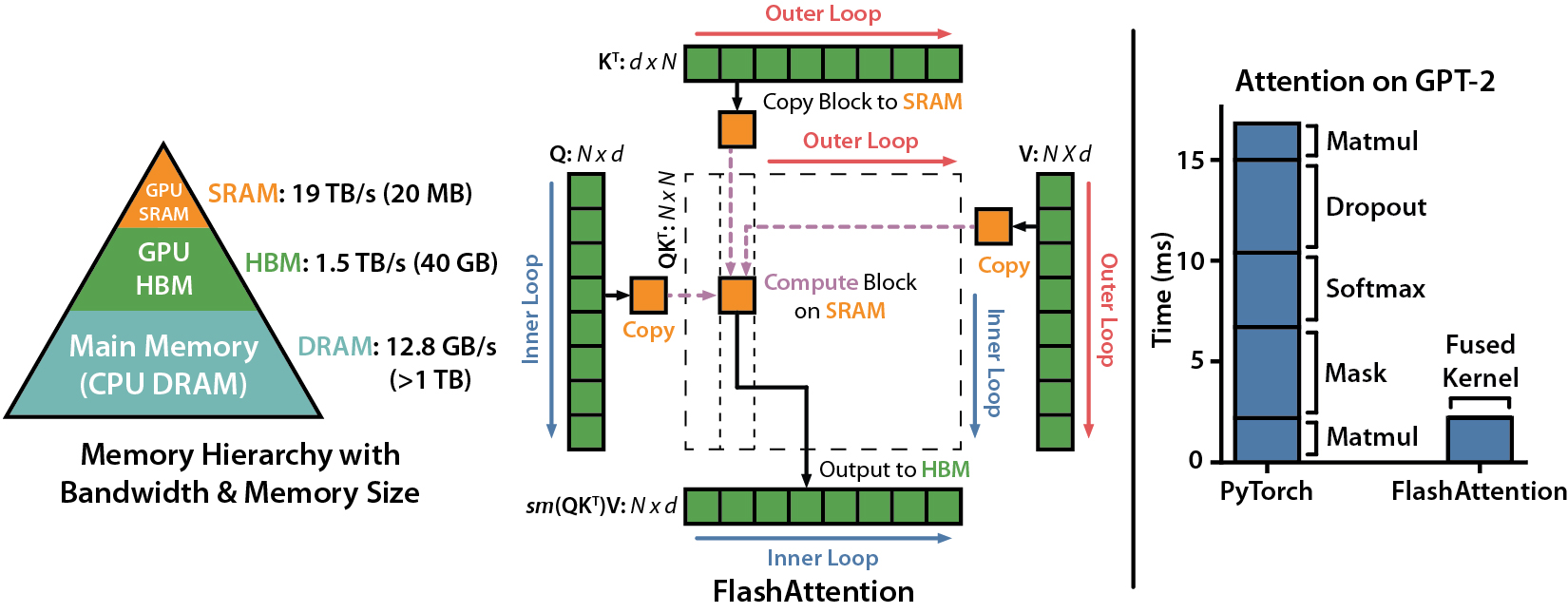
FlashAttention-2: Faster Attention with Better Parallelism and Work Partitioning
Tri Dao
Paper: https://tridao.me/publications/flash2/flash2.pdf
We've been very happy to see FlashAttention being widely adopted in such a short time after its release. This page contains a partial list of places where FlashAttention is being used.
FlashAttention and FlashAttention-2 are free to use and modify (see LICENSE). Please cite and credit FlashAttention if you use it.
Requirements:
- CUDA 11.4 and above.
- PyTorch 1.12 and above.
We recommend the Pytorch container from Nvidia, which has all the required tools to install FlashAttention.
To install:
- Make sure that PyTorch is installed.
- Make sure that
packagingis installed (pip install packaging) - Make sure that
ninjais installed and that it works correctly (e.g.ninja --versionthenecho $?should return exit code 0). If not (sometimesninja --versionthenecho $?returns a nonzero exit code), uninstall then reinstallninja(pip uninstall -y ninja && pip install ninja). Withoutninja, compiling can take a very long time (2h) since it does not use multiple CPU cores. Withninjacompiling takes 3-5 minutes on a 64-core machine. - Then:
pip install flash-attn --no-build-isolationAlternatively you can compile from source:
python setup.py installIf your machine has less than 96GB of RAM and lots of CPU cores, ninja might
run too many parallel compilation jobs that could exhaust the amount of RAM. To
limit the number of parallel compilation jobs, you can set the environment
variable MAX_JOBS:
MAX_JOBS=4 pip install flash-attn --no-build-isolationInterface: src/flash_attention_interface.py
FlashAttention-2 currently supports:
- Ampere, Ada, or Hopper GPUs (e.g., A100, RTX 3090, RTX 4090, H100). Support for Turing GPUs (T4, RTX 2080) is coming soon, please use FlashAttention 1.x for Turing GPUs for now.
- Datatype fp16 and bf16 (bf16 requires Ampere, Ada, or Hopper GPUs).
- All head dimensions up to 256. Head dim > 192 backward requires A100/A800 or H100/H800.
The main functions implement scaled dot product attention (softmax(Q @ K^T * softmax_scale) @ V):
from flash_attn import flash_attn_qkvpacked_func, flash_attn_funcflash_attn_qkvpacked_func(qkv, dropout_p=0.0, softmax_scale=None, causal=False):
"""dropout_p should be set to 0.0 during evaluation
If Q, K, V are already stacked into 1 tensor, this function will be faster than
calling flash_attn_func on Q, K, V since the backward pass avoids explicit concatenation
of the gradients of Q, K, V.
Arguments:
qkv: (batch_size, seqlen, 3, nheads, headdim)
dropout_p: float. Dropout probability.
softmax_scale: float. The scaling of QK^T before applying softmax.
Default to 1 / sqrt(headdim).
causal: bool. Whether to apply causal attention mask (e.g., for auto-regressive modeling).
Return:
out: (batch_size, seqlen, nheads, headdim).
"""flash_attn_func(q, k, v, dropout_p=0.0, softmax_scale=None, causal=False):
"""dropout_p should be set to 0.0 during evaluation
Supports multi-query and grouped-query attention (MQA/GQA) by passing in KV with fewer heads
than Q. Note that the number of heads in KV must be divisible by the number of heads in Q.
For example, if Q has 6 heads and K, V have 2 heads, head 0, 1, 2 of Q will attention to head
0 of K, V, and head 3, 4, 5 of Q will attention to head 1 of K, V.
Arguments:
q: (batch_size, seqlen, nheads, headdim)
k: (batch_size, seqlen, nheads_k, headdim)
v: (batch_size, seqlen, nheads_k, headdim)
dropout_p: float. Dropout probability.
softmax_scale: float. The scaling of QK^T before applying softmax.
Default to 1 / sqrt(headdim).
causal: bool. Whether to apply causal attention mask (e.g., for auto-regressive modeling).
Return:
out: (batch_size, seqlen, nheads, headdim).
"""To see how these functions are used in a multi-head attention layer (which includes QKV projection, output projection), see the MHA implementation.
These functions have been renamed:
flash_attn_unpadded_func->flash_attn_varlen_funcflash_attn_unpadded_qkvpacked_func->flash_attn_varlen_qkvpacked_funcflash_attn_unpadded_kvpacked_func->flash_attn_varlen_kvpacked_func
If the inputs have the same sequence lengths in the same batch, it is simpler and faster to use these functions:
flash_attn_qkvpacked_func(qkv, dropout_p, softmax_scale=None, causal=False)flash_attn_func(q, k, v, dropout_p=0.0, softmax_scale=None, causal=False)We present expected speedup (combined forward + backward pass) and memory savings from using FlashAttention against PyTorch standard attention, depending on sequence length, on different GPUs (speedup depends on memory bandwidth - we see more speedup on slower GPU memory).
We currently have benchmarks for these GPUs:
We display FlashAttention speedup using these parameters:
- Head dimension 64 or 128, hidden dimension 2048 (i.e. either 32 or 16 heads).
- Sequence length 512, 1k, 2k, 4k, 8k, 16k.
- Batch size set to 16k / seqlen.
We show memory savings in this graph (note that memory footprint is the same no matter if you use dropout or masking). Memory savings are proportional to sequence length -- since standard attention has memory quadratic in sequence length, whereas FlashAttention has memory linear in sequence length. We see 10X memory savings at sequence length 2K, and 20X at 4K. As a result, FlashAttention can scale to much longer sequence lengths.
We have released the full GPT model implementation. We also provide optimized implementations of other layers (e.g., MLP, LayerNorm, cross-entropy loss, rotary embedding). Overall this speeds up training by 3-5x compared to the baseline implementation from Huggingface, reaching up to 225 TFLOPs/sec per A100, equivalent to 72% model FLOPs utilization (we don't need any activation checkpointing).
We also include a training script to train GPT2 on Openwebtext and GPT3 on The Pile.
Phil Tillet (OpenAI) has an experimental implementation of FlashAttention in Triton: https://github.com/openai/triton/blob/master/python/tutorials/06-fused-attention.py
As Triton is a higher-level language than CUDA, it might be easier to understand and experiment with. The notations in the Triton implementation are also closer to what's used in our paper.
We also have an experimental implementation in Triton that support attention bias (e.g. ALiBi): https://github.com/Dao-AILab/flash-attention/blob/main/flash_attn/flash_attn_triton.py
We test that FlashAttention produces the same output and gradient as a reference implementation, up to some numerical tolerance. In particular, we check that the maximum numerical error of FlashAttention is at most twice the numerical error of a baseline implementation in Pytorch (for different head dimensions, input dtype, sequence length, causal / non-causal).
To run the tests:
pytest -q -s tests/test_flash_attn.pyThis new release of FlashAttention-2 has been tested on several GPT-style models, mostly on A100 GPUs.
If you encounter bugs, please open a GitHub Issue!
If you use this codebase, or otherwise found our work valuable, please cite:
@inproceedings{dao2022flashattention,
title={Flash{A}ttention: Fast and Memory-Efficient Exact Attention with {IO}-Awareness},
author={Dao, Tri and Fu, Daniel Y. and Ermon, Stefano and Rudra, Atri and R{\'e}, Christopher},
booktitle={Advances in Neural Information Processing Systems},
year={2022}
}
@article{dao2023flashattention2,
title={Flash{A}ttention-2: Faster Attention with Better Parallelism and Work Partitioning,
author={Dao, Tri},
year={2023}
}
